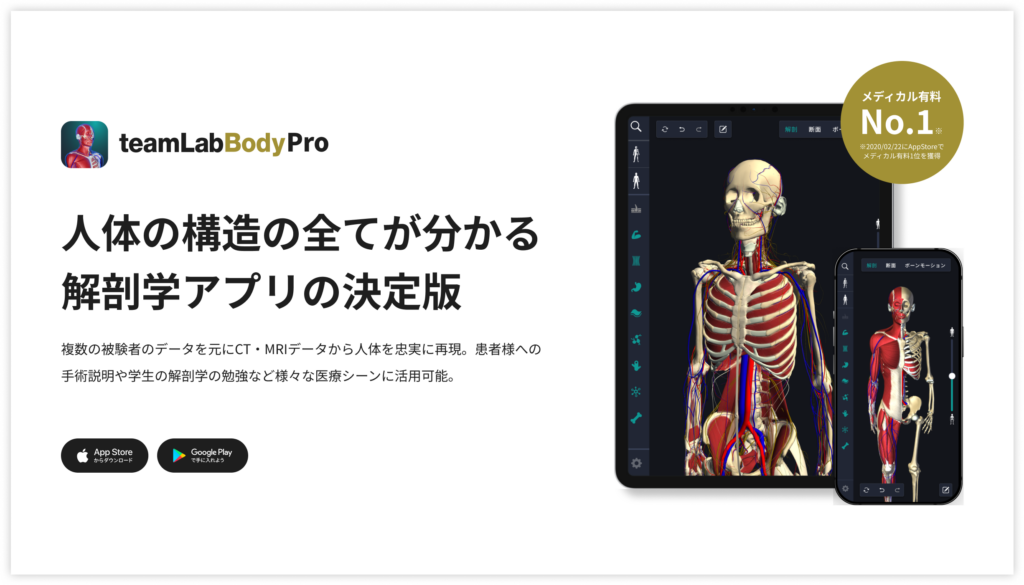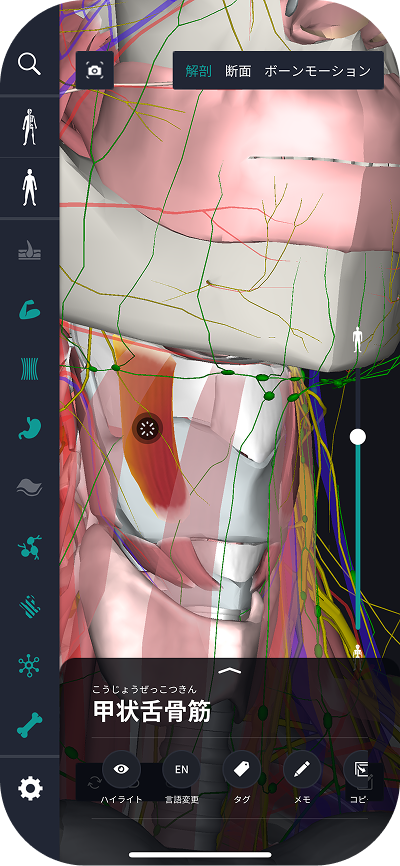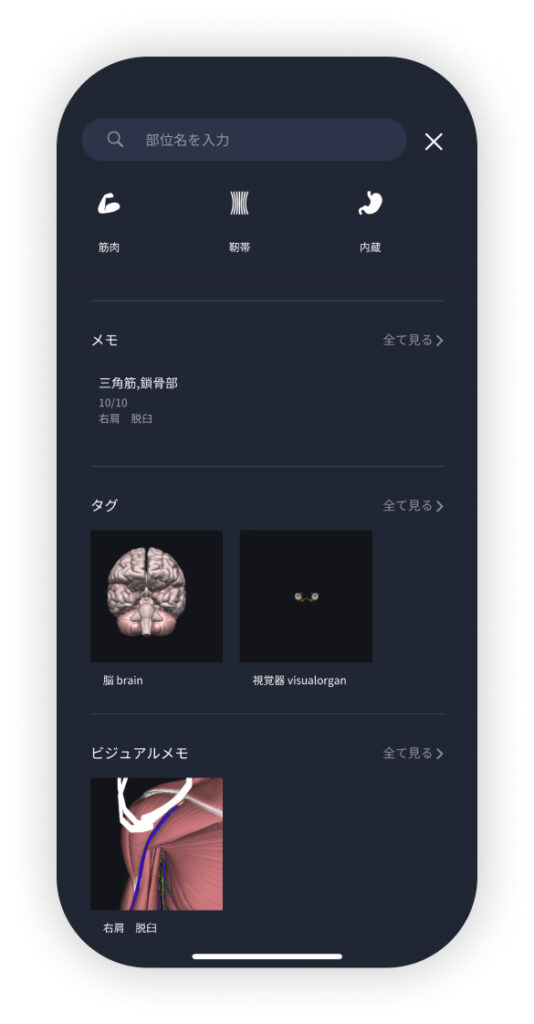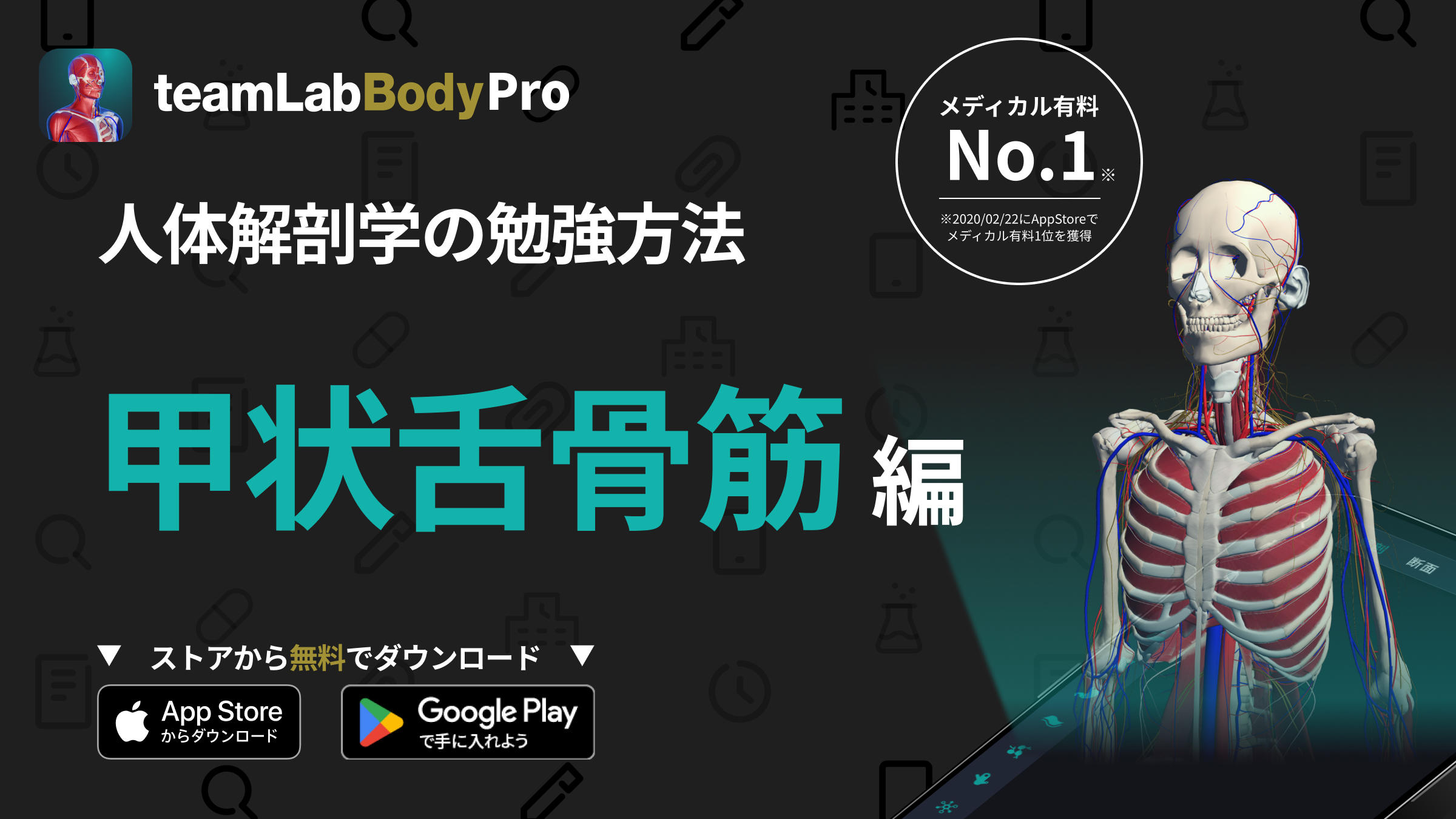beginning
In this article, I will explain effective study methods, starting with knowledge of specialized parts in human anatomy.
In human anatomy, it is necessary not only to memorize the names of various organs, muscles, and bones, but also to remember where they are located in the body. Therefore, it is necessary to learn as efficiently as possible.
I hope you will deepen your understanding even a little by reading this article and using the app.
Now, I'll explain the details about the “thyrohyoid muscle” and how to study human anatomy.
teamLab Body Pro Free Download
A 3D anatomy app that shows all the structures of the human body
Download teamLab Body Pro here!

What is the thyrohyoid muscle?
In the anatomy application, you can view a selection of anatomy 3D models. In this model, there are various observation methods such as surfaces, cross-sections, and nervous systems. This time, I'll explain using an anatomy application.
About thyrohyoid muscle

The thyrohyoid muscle (thyrohyoid muscle) is a muscle located deep in the throat, arises from the thyroid cartilage (laryngeal Buddha) and is inserted into the hyoid bone. This muscle adjusts the position of the tongue by pulling the hyoid bone upward, and plays an important role in swallowing and vocalization. In particular, when food passes through the throat by swallowing, vocalizing, and breathing, it supports safe movement into the esophagus by adjusting the position of the hyoid bone.
When the hyoid bone is pulled upward due to contraction of the thyrohyoid muscle, the larynx also rises and the vocal cords are adjusted. As a result, voice adjustments and stability during speech are maintained, so speech is also affected. In addition, this muscle is involved in protecting the airways and also works to prevent airway obstruction.
A properly functioning thyrohyoid muscle is essential for swallowing and vocalization to proceed smoothly. However, if the muscles don't work, swallowing difficulties and speech problems may occur. It is important to strengthen this muscle and maintain healthy function through rehabilitation and exercise. In particular, it is recommended to increase muscle flexibility and strength through tongue exercises and vocalization exercises.
Study points
Anatomical understanding
The thyrohyoid muscle (thyrohyoid muscle) is a muscle located in the throat that connects the thyroid cartilage to the hyoid bone. To improve anatomical understanding, it is important to first understand where this muscle is located and how it relates to other muscles and structures. The thyrohyoid muscle originates from the thyroid cartilage (larynx) and is inserted into the hyoid bone. This muscle is responsible for coordinating the movement of the hyoid bone, and affects tongue movement and swallowing.
When proceeding with learning, it is easier to visually check the starting and stopping parts of the muscles by using anatomical diagrams and models. In particular, it is important to accurately understand the positional relationship between thyroid cartilage and the hyoid bone in order to deeply understand the role and function of muscles. Furthermore, by using 3D applications and anatomical digital tools, it is possible to learn muscle structure and its movements more intuitively.
Understanding muscle function
The main function of the thyrohyoid muscle is to pull up the hyoid bone. This has an important effect on tongue movement and the process of swallowing. When the thyrohyoid muscle contracts, the hyoid bone is pulled upward to adjust the position of the tongue. This plays an important role in tongue movement and swallowing. Furthermore, contraction of the thyrohyoid muscle causes the larynx to rise, protecting the airways and helping swallowing progress smoothly.
Also, the thyrohyoid muscle is involved in vocalization. The movement of the hyoid bone is related to vocal cord coordination and voice generation, and proper function of the thyrohyoid muscle is important during speech. In particular, since normal movement of the hyoid bone supports speech stability, the health and function of the thyrohyoid muscle has a major impact on the quality of speech.
If the thyrohyoid muscle does not function properly, dysphagia and speech problems may occur. For example, swallowing may become difficult or the voice may become hoarse. By understanding these issues, we can understand the functions involved in thyrohyoid muscle and apply them to rehabilitation and treatment.
Practical applications
By understanding the thyrohyoid muscle, practical applications to problems related to vocalization and swallowing are possible. Clinically, exercises and rehabilitation may be performed to increase muscle strength and flexibility involving the thyrohyoid muscle. For example, training to promote tongue movement and swallowing is effective. Also, to improve vocalization, it is also helpful to perform exercises that strengthen the thyrohyoid muscle.
In actual treatment, rehabilitation plays an important role when dysphagia or dysphonia occurs due to decreased function of the thyrohyoid muscle. For example, exercises that move your tongue up and down and exercises that keep your throat in the correct position when making a voice are effective. As part of rehabilitation, muscle function can be improved through these exercises and stretches.
Furthermore, by understanding the effects of proper function of the thyrohyoid muscle on swallowing and vocalization, more effective treatment plans can be made. This kind of practical knowledge is also very useful for patient care in clinical settings.
How to study human anatomy
I will explain specific study methods using human anatomy applications.
Check your past learning history and practice repeatedly
Here are the steps to check your anatomy learning history and practice iteratively effectively.
1. Check your learning history in the app
Reviewing your learning history with the application is an important step in effectively advancing anatomy learning. First, launch the app and go to the learning history section from the main menu. Many anatomy apps are designed to show your progress in the form of graphs and lists, so you can visually check which parts you've learned about and how much time you've spent.
By using this data, you can understand which areas you have strengths in and where you need to spend more time and effort. We also recommend using a dedicated tag or notebook function to mark areas you are particularly weak at or where you need to relearn. Regularly checking your learning history and looking back on past learning content will lead to efficient review and deepening understanding.
2. Make a plan for iterative learning
Making an efficient repetitive learning plan based on learning history is extremely effective in promoting knowledge retention. First, identify weak points and areas where you need to relearn. Next, arrange these study items into a weekly or monthly calendar and create a specific study schedule. By proceeding in a planned manner, you can learn each part evenly and avoid packing in a large amount of information at once.
Using a task management app or digital calendar to set study reminders is effective. Also, it's important to have the flexibility to regularly review progress and revise plans as needed. By having goals and proceeding with your studies in a planned manner, you can efficiently acquire anatomical knowledge.
3.Use 3D features to learn visually
By utilizing the 3D function, learning anatomy is easier to understand visually. The 3D model shows the structure of the human body three-dimensionally, and each part can be observed in detail. This makes it possible to intuitively grasp positional relationships between deep muscles and organs that are difficult to capture in a planar view. For example, you can learn even the smallest details by rotating specific muscles and bones and zooming in and out.
Also, there are many apps that have the function of displaying cross-sectional views of each part using a 3D model, which is useful for deepening understanding of internal structures. This diversity of visual information helps with memory retention and improves immediate responsiveness in tests and practice situations. By utilizing the 3D function and learning visually, you can learn anatomy knowledge more deeply and efficiently.
Use the memo function concretely

Make notes so you don't forget the things and points you've noticed while studying. The memo function can be used for different purposes, such as inputting text, saving images, and writing memos. Tag your notes to make them easier to review later.
Test your learning regularly in the form of quizzes
Regularly testing what you've learned in a quiz format is a very effective way to anchor your anatomy knowledge. Quiz-style tests help you objectively grasp your level of understanding and areas you lack while repeating knowledge.
For example, by using a learning app to conduct quizzes every specific period, you can reconfirm what you've learned and strengthen your memory. There are a wide range of quiz formats, such as multiple choice questions, fill-in-the-blank questions, and short answer questions, and each helps understanding from a different angle and develops the ability to utilize various types of knowledge.
Get feedback
If possible, get feedback from other learners and experts. It helps you find your own gaps in understanding and areas for improvement. You can also keep yourself motivated to learn by regularly testing yourself. Feeling a sense of accomplishment and progress increases motivation for continuous learning.
summary
This time, I explained how to study “thyrohyoid muscle” using an application!
Thank you for reading this far.
I would be happy if reading this article helped you learn about anatomy.
Learning is a long, never-ending journey, but I sincerely wish you all the best. Let's continue to study together and work hard for the national exam!
Please look forward to the next blog.
teamLab Body Pro Free Download
A 3D anatomy app that shows all the structures of the human body
Download teamLab Body Pro here!





